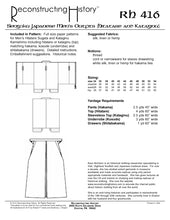What Every Fashionable Bushi is Wearing This Season! (and next season too!)
In a complete reversal from the usual flow of fashion, the Hitatare outfit began life as the daily wear of common labourers in Heian period Japan (794-1172 CE). It looked so comfortable that soon the nobles of the Heian court began to wear it as a jacket on cold evenings.
When the Kamakura Bakufu ostensibly took over rule of the country in the late 12th century, the aristocracy and high-ranking military officials preserved the Court clothing of the Heian period. But at home or when traveling, even the most exalted Japanese men wore Hitatare. In the Kamakura period, Hitatare was still casual dress. By the Muromachi period (1333-1573 CE), it was formal wear.
In the Momoyama period (1573-1603 CE), a variation of the Hitatare came into being. Called Kataginu (shoulder gown), it was basically a sleeveless version of the Hitatare. This quickly became the typical daily clothing of samurai.
Our pattern includes easy-to-follow, step-by-step instructions on how to construct Hitatare and Kataginu Sugata in a period manner (as well as directions for machine sewing). Includes the hitatare (top), kataginu (sleeveless top), matching hakama (pants), kosode (undershirt) and shitabakama (drawers). Also included are extensive historical notes on the origin and appropriateness of hitatare and kataginu, colour, embellishment, and fabric suggestions, and directions on how to get dressed.
All you need is the shoes!
Fits chests 34" to 54" and waists 28" to 50". All sizes in one envelope.
Also included are assembly instructions, embellishment suggestions, and the extensive historical notes you've come to expect from Reconstructing History.
Suggested Fabrics: silk, linen or hemp
Notions: thread, cord or narrowware for sleeve drawstring, white silk, linen or hemp for hakama ties
Yardage Requirements:
Pants (Hakama) - 2.5 yds 45” wide
Top (Hitatare) - 4 yds 60” wide
Sleeveless Top (Kataginu) - 2.5 yds 60” wide
Underrobe (Kosode) - 3 yds 60” wide
Drawers (Shitabakama) - 1 yd 60” wide




